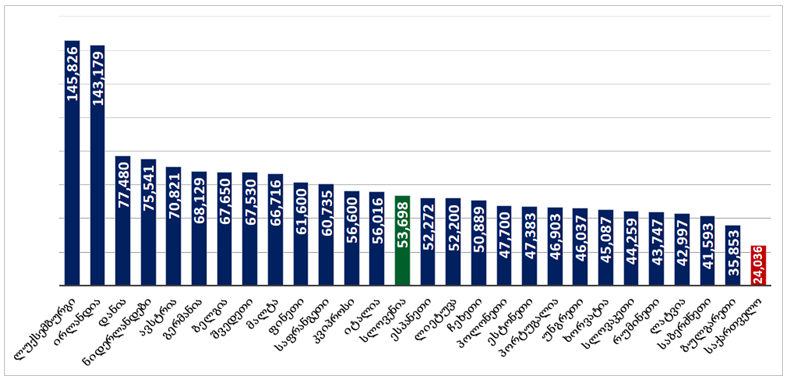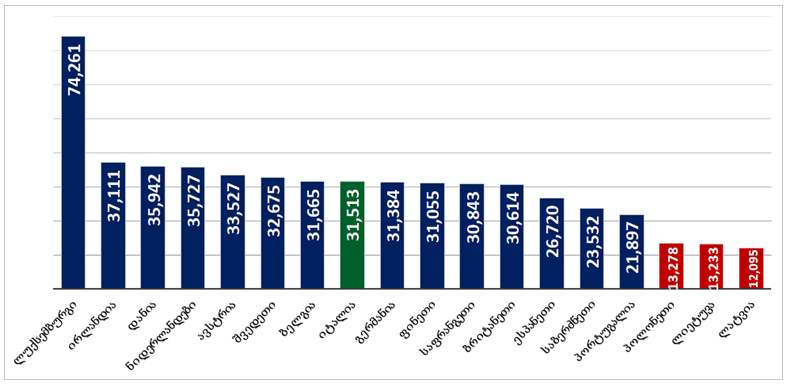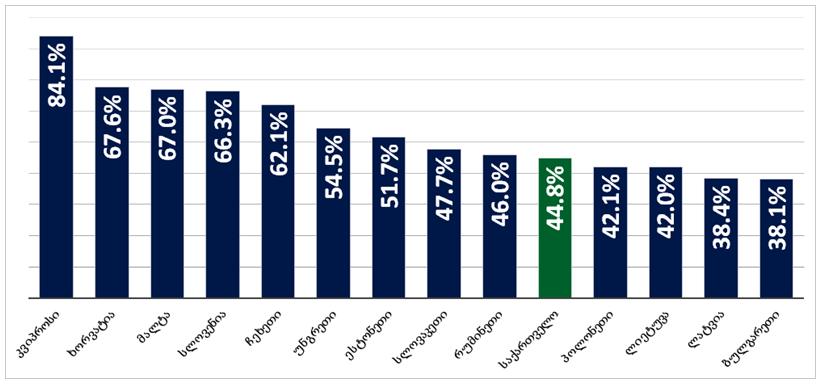Lasha Khutsishvili: “The per capita income of Georgia is expected to reach 45% of the European Union median by 2024.”
Verdict: FactCheck concludes that Lasha Khutsishvili’s statement is MOSTLY TRUE.
The European Union’s median gross domestic product per capita, measured by the purchasing power parity (PPP) method, is expected to be held by Slovenia at USD 53.7 thousand in 2024 as per the International Monetary Fund’s projections. This implies that 13 amongst the EU member states will exceed Slovenia in GDP (PPP) per capita whilst the remaining 13 will fall below it.
Georgia’s GDP (PPP) per capita is expected to reach USD 24 thousand in 2024, equivalent to 44.8% of Slovenia’s figure, according to the same International Monetary Fund forecast.
Lasha Khutsishvili specifically referenced Lithuania, Latvia, Poland and Bulgaria, indicating that their GDP per capita fell below 45% of the European median when they joined the EU. This claim holds true as the GDP per capita of the aforementioned countries varied between 38% and 42% at the time of their accession. Additionally, nine other countries that joined the EU between 2004 and 2013 exceeded the 45% threshold relative to the median GDP.
Although the data stated by the candidate for the Minister of Finance for Georgia and the referenced countries are accurate, it is crucial to note that the information was selectively chosen, therefore not giving enough information to see the full perspective. Considering all the above, FactCheck concludes that Lasha Khutsishvili’s statement is MOSTLY TRUE.
Analysis:
During the parliamentary session of the joint committee on 6 February, the candidate for the Minister of Finance, Lasha Khutsishvili, in discussing economic metrics, stated: (from 3:03) “Georgia’s GDP per capita, measured in purchasing power parity, is expected to constitute 45% of the European Union median in 2024 as per the International Monetary Fund’s projections. Comparing this to the experiences of four out of the 13 countries that joined the EU in the 2000s – namely Poland, Lithuania, Latvia and Bulgaria – it is noteworthy that their respective figures were even lower at the time of their accession to the Union.”
A country must meet specific criteria for it to join the EU. Although legislative harmonisation and democracy levels are placed greater emphasis on, economic conditions are also considered whilst joining an economic union. The gross domestic product per capita is considered a key indicator of a country’s economic development in this context.
The European Union comprises 27 countries as of 2024 and the median per capita income in PPP reflects the state of the 14th country.
Graph 1: Forecasted 2024 Values of Income Per Capita in Purchasing Power Parity of the EU Member States and Georgia (International Dollar[1])

Source: International Monetary Fund
Slovenia is projected to have a median GDP (PPP) per capita of USD 53.7 thousand in 2024 whilst Georgia is forecasted to reach USD 24 thousand, amounting to 44.8% of Slovenia’s figure. Hence, the first half of Lasha Khutsishvili’s statement holds true.
Moreover, Lasha Khutsishvili named four additional countries, three of which – namely Poland, Lithuania and Latvia – joined the EU during the fourth enlargement in 2004 whilst Bulgaria joined during the fifth enlargement in 2007.
The EU comprised 15 countries in 2003 with Italy holding the median per capita income at USD 31.5 thousand. Poland’s per capita income was USD 13.3 thousand, Lithuania’s was USD 13.2 thousand and Latvia’s was USD 12.1 thousand at that time – amounting to 38%-42% of Italy’s figure. It is noteworthy that Estonia, part of the Baltic region that joined the EU alongside Latvia and Lithuania, was at a better economic position with its figure at 51.7% of the EU median.
Graph 2: GDP (PPP) Per Capita of the EU Member States, Poland, Lithuania and Latvia in 2003 (International Dollar)

Source: International Monetary Fund
The number of EU member states had increased to 25 by 2006 with Cyprus holding the median value at USD 32 thousand. Bulgaria’s GDP per capita was USD 12.2 thousand at that time, amounting to 38% of Cyprus’ figure.
Graph 3: GDP (PPP) Per Capita of the EU Member States and Bulgaria in 2006 (International Dollar)

The latter part of Lasha Khutsishvili’s statement, suggesting that the GDP (PPP) per capita of Lithuania, Latvia, Poland and Bulgaria fell below 45% of the EU median value, holds true as well. However, it should be noted that this comparison does not include the figures of nine countries that joined the EU in the years spanning 2004 to 2013.
Graph 4: GDP (PPP) Per Capita as Compared to the EU Median. Georgia in 2024; Other Countries at the Time of Their Accession

Source: International Monetary Fund
Poland initiated its application for accession into the European Union in 1994 and the process took a decade to complete. In comparison, Lithuania and Latvia applied in 1995 and it took them nine years to join the EU. Similarly, Bulgaria applied in 1995 but had to wait 12 years until its accession in 2007.
Furthermore, the EU enlargements starting from 2004 predominantly included less affluent countries from the Socialist camp, contributing to a decline in the average and median GDP of the Union. Georgia would have constituted 36% of the EU median, nine percentage points lower than the current ratio, had it joined the EU under the conditions prevailing during the accession of Lithuania, Latvia and Poland in 2004 (thus, six percentage points lower than Lithuania and Poland and two percentage points lower than Latvia at the time of their accession). The median figure within the EU mirrored that of Sweden, a developed economy in this case.
Graph 5: Forecasted Income Per Capita (PPP) of Georgia and the EU Member States Prior to the Fourth Enlargement (International Dollar)

Source: International Monetary Fund
If we adjust for the conditions prior to Bulgaria’s accession in 2007, with 25 countries being in the EU, Georgia’s GDP per capita would have amounted to 42.5% of the EU median figure (four percentage points higher than that of Bulgaria as of its accession), close to the current value of 44.8%.
Graph 6: Forecasted Income Per Capita (PPP) of Georgia and the EU Member States Prior to the Fifth Enlargement (International Dollar)

Source: International Monetary Fund
Whilst various aspects are to be considered when forecasting a country’s EU membership, it can, nevertheless, be asserted that Georgia’s economic metrics align with those of EU member states that joined the Union after 2004 at the time of their respective accessions.
The candidate for the Minister of Finance overlooks the fact that whilst Georgia’s GDP in purchasing power parity (PPP) relative to the EU median is currently higher than that of Poland, Lithuania, Latvia and Bulgaria at the time of their accessions, it lags behind the remaining nine countries that were granted EU membership from 2004 to 2013. Thus, considering the accurately presented but certain selectively emphasised figures, FactCheck concludes that Lasha Khutsishvili’s statement is MOSTLY TRUE.
[1] An artificial currency used to eliminate purchasing power differences with its purchasing power being equivalent to that of a USD.








